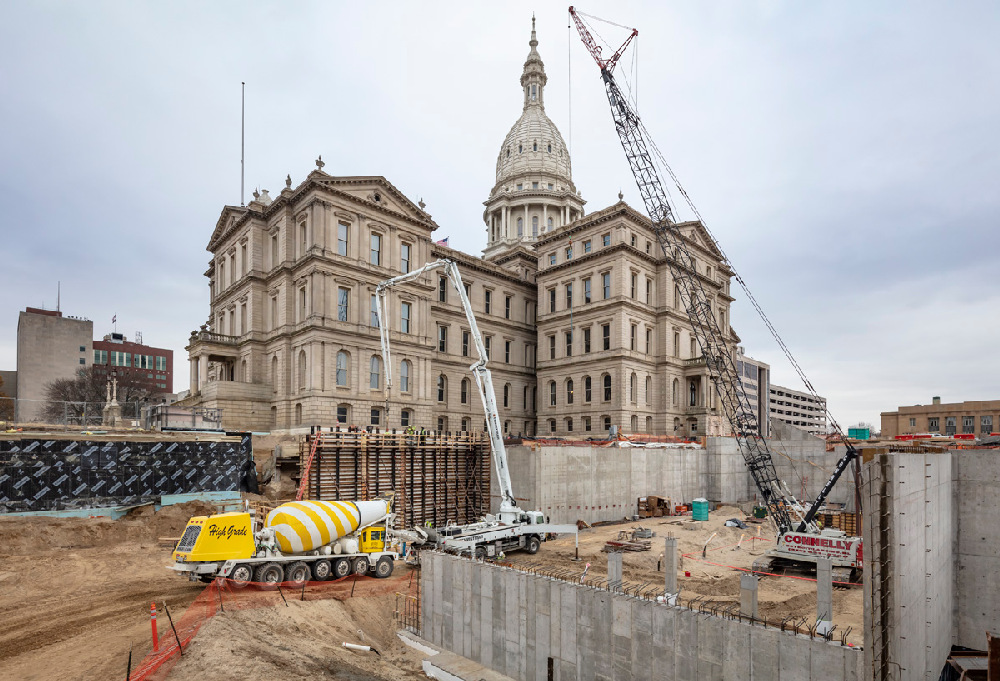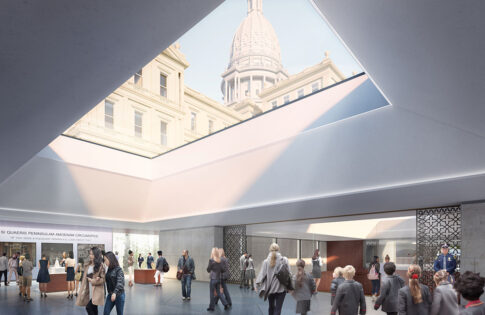
Building within a geothermal field at a historic site
By Phil Root
The Michigan State Capitol opened in 1879 in Lansing. As with historic structures, it has undergone multiple restorations. Following an exterior restoration in 1992, it was named a National Historic Landmark and welcomes more than 115,000 visitors annually. After the 1992 restoration, protection of newly renovated spaces became a top priority, and state officials discussed adding a welcome center.
After the exterior dome and stone façade restoration in 2015, a $70-million infrastructure project was approved to repair failing systems. Work included electrical, mechanical, plumbing, fire suppression/alarm and building control systems with a new geothermal field. At this time, a $110-million welcome center was proposed in conjunction with infrastructure repairs, knowing that a geothermal field could prevent future lawn projects.
The welcome center did not pass legislative approval, and the infrastructure project and geothermal field addition proceeded in 2017. Two years later, the legislature approved a smaller welcome center, called Heritage Hall, budgeted at $40 million. This construction was added to the 90% complete infrastructure project. Heritage Hall is a 40,000-square-foot underground exhibit facility, bus loop and 300-person conference hall.
The Michigan State Capitol Commission hired Christman as a Design-Build partner for all of its building projects and they involve our team in all planning phases. As part of the infrastructure project, the new geothermal field installation began on the west side of Capitol Square — projected to be one of the country’s largest state capitol geothermal systems. Based on the engineering study, the team replaced approximately 350 fan coil units and over a dozen air handler units. They also constructed an underground central utility plant and generator vault to house the new head end mechanical systems, such as the geothermal heater chiller, new electrical substation and two 600kw generators.
The infrastructure upgrades project equipment startup, to begin using the geothermal energy, and the field completion was paused so that the utility plant and geothermal field could be modified to support Heritage Hall. The goal was to advance the projects while managing the owner’s vision and budget.
Geothermal advantage
 A geothermal system does not burn fuels like coal or natural gas and over its lifecycle is more economical, with projected energy reduction of 30% and payback in 10 years. It also removes load from the local steam utility supply and reduces annual costs.
A geothermal system does not burn fuels like coal or natural gas and over its lifecycle is more economical, with projected energy reduction of 30% and payback in 10 years. It also removes load from the local steam utility supply and reduces annual costs.
Installing a system to support the Capitol’s energy needs required a large green space for in-ground wells and equipment. The team drilled 224 geothermal wells to 500 feet. With the late addition of Heritage Hall, buy-out began quickly for earth retention, since we were modifying already-placed geothermal wells and building an underground structure.
During months-long planning with excavating — the earth retention and geothermal subcontractors — a design update and complex event sequence was developed. The process began with earth retention where we opted for vibration setting the steel pile columns to avoid displacement of the earth around the geothermal wells, as opposed to auger setting with slurry. Once the retention piles were set, we implemented a painstaking process with our excavator removing earth in five-foot-deep increments, followed by the earth retention subcontractor installing wood lagging. When installing lagging, our geothermal contractor exposed the wells at the five-foot increments, cut them down below current grade elevation, pressurized them and then started the process over again for the next five feet of removal. In all, up to six rounds totaling 30 feet were removed.
Water pressurization revealed if any wells were compromised during excavation. With no trucks or pans onsite, material removal challenges were solved with a loader, which addressed limited accessibility with geothermal wells 20 feet on center in an active excavation. Essentially, we worked ourselves out of the hole. This process took four months, without losing a single existing well during the excavation.
Another challenge we encountered when building on top of the wells involved tiebacks, which held the earth retention walls and had to be drilled through the surrounding geothermal field. On the surface, all of the tieback locations needed to be coordinated to avoid wells through survey layout.
Lateral piping for a series of wells were pressurized to know immediately if they hit an in-place well. Additionally, our south crane pad had several tiebacks that were perpendicular to other tiebacks and the geothermal wells, because the earth retention formed an outside 90 degree angle – a first for our team. Extra tiebacks also supported a crane used to fly in materials for footings, foundations, poured walls and more.
Historic preservation solutions
National historic landmarks require a consult with local historic preservation societies and owners to preserve the historic fabric throughout construction. To connect the underground elevator shaft of the new Heritage Hall to the Capitol’s ground floor, we constructed a robust secant wall against the 140-year-old masonry building as part of the earth-retention system. The shaft and concrete foundation walls were anchored to the six-foot-diameter secant wall. Also, the existing stone portico stair structure required removal and salvage to install an entry vestibule and stair addition for Heritage Hall. The original stair is built over the underground stairway into Heritage Hall supported by new concrete and steel beam construction.
As a 40-year construction veteran, this was like nothing I had ever experienced. Since the building is fully occupied, noise, vibration and safety were paramount. Unforeseen pandemic challenges delayed material procurement, along with inflation impacts, which required constant adjustments to schedule and sequence. We worked collaboratively and creatively with the owner, designers, engineers and subcontractors to make these complex processes possible. In the end, we delivered a building that will function economically, while also fulfill a decades-long owner dream.
Phil Root is a senior project superintendent with The Christman Company.


 Join our thriving community of 70,000+ superintendents and trade professionals on LinkedIn!
Join our thriving community of 70,000+ superintendents and trade professionals on LinkedIn! Search our job board for your next opportunity, or post an opening within your company.
Search our job board for your next opportunity, or post an opening within your company. Subscribe to our monthly
Construction Superintendent eNewsletter and stay current.
Subscribe to our monthly
Construction Superintendent eNewsletter and stay current.